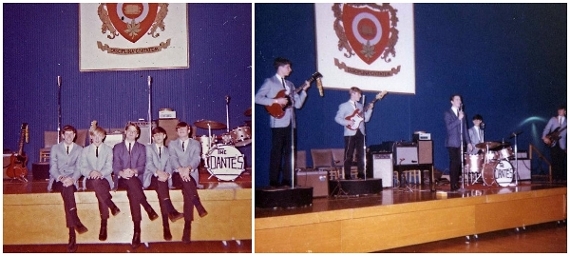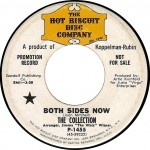It was terrific to speak recently to Dave Yarnell, guitarist and singer with the Plum Beach Incident, whose sterling “Pretty Thing” I first featured back in 2010 in a post surveying ‘60s jangle pop. A warm, friendly gentlemen whose continued passion for music was obvious, Dave filled me in on some of his ‘60s band history, and the story of the Plum Beach Incident.
Early life and Dantes
The son of an educator, Yarnell was born in Sacramento, CA, relocating with his family early in life to his family’s home state of Ohio, where he grew up. Inspired by West Coast surf music and the rock ‘n’ roll of pre-British-Invasion groups like the Beach Boys, the Kingsmen, and Ventures, the self-taught Yarnell began playing guitar in the sixth or seventh grade.

- Early version of the Dantes. Playing at Ohio State University, circa 1964.
In high school Yarnell and his classmate Richard Wakefield formed an early edition of the Dantes. (Yarnell referenced local group the Electras – the future Fifth Order – as an inspiration, noting their musical equipment and use of bar chords in particular.)

- An early songlist for the Dantes, circa 1964
Halfway through high school in 1965, Yarnell moved with his family to Falls Church, Virginia, a town just outside the D.C. beltway. The Dantes would go on to eventually enjoy some success – a few of their 45s charted in Ohio – but, by that point, Yarnell was no longer with the group.
Ye Bay Rums
Yarnell was serious about music. “I had a natural ear for harmony” – and he’d sometimes be seen carrying an inverted history book to strengthen the chording muscles in his hands. He wasted no time in founding a new group, Ye Bay Rums, as a junior at George Mason High School.
 Ye Bay Rums included Tim Woolsey (drums), George Cotner (Hammond organ and vocals), Tom Turrisi (bass) and Yarnell (guitar and vocals). The group played local events, dances (“Great money for kids in high school”) and the occasional opening slot for touring artists like the Ohio Express and Wilson Pickett. The group’s repertoire featuring period covers (Beatles, Sam & Dave, Young Rascals, Wilson Pickett) along with the occasional band original like Yarnell’s “Picture with the Eyes that Move” and Cotner’s “Love Came on” and “Let Me Make it Up.” Yarnell also played cornet in his high school’s band and would, along with Cotner (a fellow horn player) be seen grabbing his horn onstage for covers of “Land of 1000 Dances” and “Midnight Hour” and other period soul and R&B.
Ye Bay Rums included Tim Woolsey (drums), George Cotner (Hammond organ and vocals), Tom Turrisi (bass) and Yarnell (guitar and vocals). The group played local events, dances (“Great money for kids in high school”) and the occasional opening slot for touring artists like the Ohio Express and Wilson Pickett. The group’s repertoire featuring period covers (Beatles, Sam & Dave, Young Rascals, Wilson Pickett) along with the occasional band original like Yarnell’s “Picture with the Eyes that Move” and Cotner’s “Love Came on” and “Let Me Make it Up.” Yarnell also played cornet in his high school’s band and would, along with Cotner (a fellow horn player) be seen grabbing his horn onstage for covers of “Land of 1000 Dances” and “Midnight Hour” and other period soul and R&B.
Ye Bay Rums made some demo records for Lionel Hampton’s Glad Hamp Records, but, while there was commercial interest, nothing was actually released. By 1967 Yarnell had graduated high school and began attending Corcoran School of Art in D.C.. Ye Bay Rums would disband in 1968.
Plum Beach Incident
The Plum Beach Incident was started around 1968 by Art Morales, a colorful local musician who modeled himself on guitarist Eric Clapton, then with Cream.

- The Plum Beach Incident. (front, l-r): Arturo Morales, Sharon Theet, Johnny Smith, Karen Theet, Keith Edwards; (rear): Steve Croson. Note: Yarnell is not pictured.
Yarnell’s involvement began upon answering an audition ad posted by Morales at a local music store in 1968. The group – which would largely coalesce through Morales – would come to include Johnny Smith (keyboards), Steve Croson (bass), both previously of the Organic Cavemen – a popular Northern Virginia band, Keith Edwards (drums – the “hippie-est,” according to Yarnell), and the telegenic singers (and sisters) Sharon and Karen Theet. Everybody in the group sang. The group was listening to and performing a lot of West Coast psychedelic rock at the time. (Yarnell also cited the Bee Gees’ “Words,” the Doors’ “Love me Two Times” and covers of Dionne Warwick and Dusty Springfield, with the Theet sisters assuming lead vocal duties.

- The Plum Beach Incident playing the Knights of Columbus hall in 1968. (l-r): Steve Croson, Sharon Theet, Karen Theet, Dave Yarnell, Johnny Smith, Arturo Morales, Keith Edwards.
The Plum Beach Incident played live around northern Virginia, Washington D.C. and Maryland, attaining enough local celebrity to land opening slots for nationally-known artists like Vanilla Fudge as they came through the area. The group also shared stages with local groups of the day like the Fallen Angels, the English Setters, and later, the Cherry People.

- Envelope direct from Orpheum Records to Arturo Morales. Postmark August 1968.
The Plum Beach Incident, Pretty Thing
The group’s management team helped facilitate the recording session that led to “Pretty Thing” along with its flipside “Summer Love.” The session took place over the course of a few days in New York City in August 1968. The lyrics were handed to the Plum Beach Incident, the arrangement and interpretation were entirely the group’s own. In addition to the 45, a few other songs were also recorded in that time to acetate, including an original, “You Need a Friend.”

- Plum Beach Incident, 1968. (l-r): Steve Croson, Sharon Theet, Arturo Morales.
Despite its potential – “Summer Love” was discussed for placement in a Clairol advertisement at one point – the 45 was not a commercial success. It probably didn’t help that its release was delayed in deference to Gary Lewis and the Playboys’ version of “Pretty Thing,” or that Orpheum Records, along with its sister label Pop-Side, was winding down its operations by the late ‘60s.
The group lasted less than two years, the pressures of the draft, drug busts, lifestyle changes, pregnancies and family life eventually finally catching up with them.
After the Plum Beach Incident
Of the group, it was bassist Steve Croson – he passed away in 2010 – who enjoyed the most success in the music world – playing and singing on a number of Nashville country sessions, touring for years with various country music artists and, in recent years, founding the Roy Orbison tribute show “In Dreams.”
Yarnell enlisted for a stint in the Air Force as an AF Illustrator after being drafted in 1969, and would afterwards return to finish his studies in fine art. He started a family along the way, worked as a graphic artist and, later, as a licensed boat captain between D.C. and the Florida Keys. Dave still plays music, and currently can be heard playing around northern Virginia as Capt. Dave and the Neptunes.
Many thanks to Dave Yarnell for the archival photos, and for this interview.
































